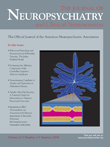Persistent Akinetic Mutism After Bilateral Paramedian Thalamic Infarction
To the Editor: Akinetic mutism is a pathological condition characterized by lack of spontaneous movements with little or no vocalization in subjects with intact corticospinal pathways. 1 This condition was first described in patients who suffered diencephalic damage, and current evidence indicates that it is a transient state resulting from lesions that interfere with reticular/cortical integration. 2 We present a rare case of persistent akinetic mutism after bilateral paramedian thalamic infarction.
Case Report
S.I., an 81-year-old man without any significant previous medical history, was admitted to the Department of Neurology at Amedeo Avogadro University in Novara, Italy, after the acute onset of bilateral thalamic infarct. On admission he presented with a sleep-like state, respiratory failure, unresponsiveness, and double incontinence. While he was physically and emotionally active before stroke, he became apathetic, aspontaneous, indifferent, and seemed to have lost motor and affective drive, as well as the need itself for any psychic activity. A brain CT and MRI, performed on admission and during the following week, showed bilateral ring-shaped signal alterations in the paramedian thalamic regions with the right one being characterized by major dimension. The signal hyperintensity in long TR sequences and the hypointensity in T1 sequences were consistent with right paramedian artery territory infarction and contralateral territory involvement, which presumably led to ischemic lesions of paramedian and intralaminar nuclei. Electroencephalographic recordings demonstrated diffuse cortical slowing associated with epileptiform discharges. During hospitalization, the patient showed no sign of recovery, with the exception of normal sleep-waking cycle. At 6-month and 1-year follow-up visits he still met Cairns’ criteria for akinetic mutism.
Discussion
Bilateral thalamic infarcts are uncommon, as they represent about 0.6% of first ever acute stroke. 3 The most common clinical picture associated with bilateral paramedian thalamic artery infarction includes coma, loss of consciousness or somnolence at stroke onset, followed by transient concentration and orientation deficits, and memory dysfunctions (thalamic dementia). More rarely, small bilateral thalamic lesions can also lead to the clinical pictures of akinetic mutism (failure to respond to relevant stimuli) and athymhormia (“loss of psychic self-activation”). 2 – 4
Akinetic mutism is usually a transient condition, whereas with both thalamic dementia and athymhormia there is less of a chance of recovery. In our patient, the damage extended from the paramedian to intralaminar nuclei, possibly leading to permanent disruption of higher-level thalamocortical integration pathways controlling consciousness, without affecting the core of pontine tegmentum, whose damage is selectively associated with coma. 5 On the other hand, the circuitry from intralaminar thalamic nuclei to the prefrontal cortex and back to the nucleus reticularis has been suggested to serve as a gate control, selectively preparing the aroused organism for responses to meaningful stimuli. 6
1. Cairns H, Oldfield RC, Pennybacher JB, et al: Akinetic mutism with an epidermoid cyst of the third ventricle. Brain 1941; 64:273–290Google Scholar
2. van Domburg PH, ten Donkelaar HJ, Notermans SL: Akinetic mutism with bithalamic infarction: neurophysiological correlates. J Neurol Sci 1996; 139:58–65Google Scholar
3. Kumral E, Evyapan D, Balkir K, et al: Bilateral thalamic infarction. Acta Neurol Scand 2001; 103:35–42Google Scholar
4. Engelborghs S, Marien P, Pickut BA, et al: Loss of psychic self-activation after paramedian bithalamic infarction. Stroke 2000; 31:1762–1765Google Scholar
5. Parvizi J, Damasio A: Neuroanatomical correlates of brainstem coma. Brain 2003; 126:1524–1536Google Scholar
6. Crick F: Function of the thalamic reticular complex: the search light hypothesis. Proc Natl Acad Sci U S A 1984; 81:4586–4590Google Scholar



